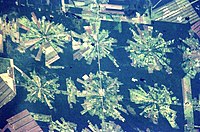
Photo from wikipedia
Abstract For eight rivers situated from northern to southern Italy, the evolutionary trajectories since the middle 19th century and the key controlling factors of channel adjustments were reconstructed using a… Click to show full abstract
Abstract For eight rivers situated from northern to southern Italy, the evolutionary trajectories since the middle 19th century and the key controlling factors of channel adjustments were reconstructed using a combined diachronous-synchronous approach, integrating data from catchment- to reach-scale. The analysis takes advantage of multi-temporal GIS analysis of maps, aerial photographs, and orthophotos, and data from literature, archives, and official surveys of population and agrarian censuses. The main aims were to link historical channel responses to human and climate disturbances evidencing regional scale similarities and dissimilarities and to explain the role of upland and floodplain land use changes in the interpretation of channel adjustments. From the middle 19th century to the 1950s, both channel widening and narrowing were observed. These processes were related to land use disturbances (e.g., afforestation versus deforestation) acting at both reach and catchment scales. From the 1950s to 1970s, channel narrowing in some rivers accelerated simultaneously with forests encroachment on fluvial corridors and human abandonment of intense floodplain uses, before the action of any other factors. In southern Italian rivers, channel adjustments were more intense and occurred later than in northern ones, but they remained more active once adjustment ended. Even though these rivers underwent a rural decline, their floodplains were little colonized by mature forests, probably because of drier climatic conditions exacerbated by dewatering due to channel incision. This also means that upland afforestation, with its effects on bedload delivery, was a more critical driver in controlling narrowing than floodplain afforestation, as in this southern context we do not observe floodplain afforestation but grazing expansion. When forest can establish along the channel, as seen on the Volturno River, narrowing is even more important. River widening in the early 2000s–2010s did not compensate for longer term narrowing, demonstrating a shift in river responsiveness that was partly due to upland and floodplain afforestation inducing higher channel resistance to bank erosion and bedload deficit. Such morphological evolution was also observed in Southeastern France, but occurred a bit earlier, with stronger similarities with northern Italy and the Apennines. These drivers of change must not be underestimated in geomorphic diagnosis, even if they are more difficult to assess.
Journal Title: Catena
Year Published: 2020
Link to full text (if available)
Share on Social Media: Sign Up to like & get
recommendations!